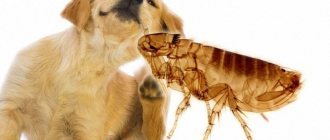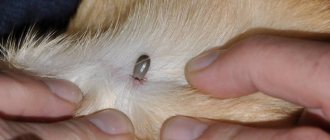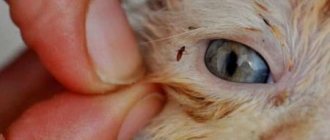What are ectoparasites
The entire numerous group of small parasites that a dog, cat or other animal, as well as in some cases a person, may encounter, but differ in that they do not affect the internal organs of the donor, but settle on his skin, hair or fur, are called ectoparasites .
Important! The term “ectoparasite” has ancient Greek roots and consists of two words: ἔκτος, i.e. external, external, and παράσιτος - parasite, parasite. Pests that settle inside the body of the “host” are, accordingly, called endoparasites, from the ancient Greek “
ἔνδον" - inside.
It is incorrect to call ectoparasites insects, since among them there is a large number of different mites, which, although they belong to the arthropod subclass, belong to another order, namely, arachnids.
A characteristic feature of all ectoparasites is the presence of special organs with which they attach to the donor. Such devices can be a variety of suction cups, hooks, claws, stings, etc.
The main difference in the harmful way of life of various parasites is that some of their species feed on different victims, without tying themselves to a specific donor individual (the most striking example of such pests is the mosquito); others, having chosen a donor, settle down thoroughly on his body, live, develop and reproduce for a long time at the expense of the same animal, and sometimes, although this happens quite rarely in relation to ectoparasites, their vital activity leads to the death of the “breadwinner”.
The most unpleasant thing for both dogs and humans is contact with such constant pests. They are characterized by the following common features:
- eating small meals frequently;
- rapid death in the absence of food;
- average or low reproduction rate;
- short period of development from larva to adult;
- short lifespan.
Important! An ectoparasite can settle on a victim’s body in two ways - contact and “hereditary”, i.e. from a larva already deposited on the external organs of the donor (the so-called phoresia).
Common Types of External Parasites in Dogs
The number of ectoparasites in the world is simply enormous. Only among pests that constantly live on the body of vertebrate animals living on land, modern science includes about 10,000 species. But the most common in this series are fleas, lice, bedbugs, lice eaters, mosquitoes and various types of ticks.
Fleas
Fleas are the name of a group of wingless insects that feed on the blood of vertebrates. To ensure this way of existence, during the process of evolution, fleas have formed a special proboscis, with the help of which the parasite pierces the body of the victim and sucks blood from it. To ensure that the nutrient flow does not stop, insects simultaneously with the bite inject a special enzyme into the puncture site that does not allow the blood to clot; however, unlike some other parasites, the flea does not provide an analgesic effect to its victim, which is why flea bites are very painful and cause the animal suffers a lot.
Science knows more than 2 thousand species of fleas, and at least 4 of them are officially recognized as extinct today. There are approximately 500 species of fleas found in Russia and other Eastern European countries.
Dogs, cats, rabbits and other domestic animals are parasitized by members of the common flea family (Pulicidae), and these insects have a narrow specialization and stable taste preferences. Thus, the flea species Ctenocephalides canis usually lives on the body of dogs (cat fleas are Ctenocephalides felis, rabbit fleas are Spilopsyllus cuniculi, etc.).
The average flea size ranges between 0.5 and 5 mm, and the body is dark brown or black. Thanks to a pair of long hind limbs, the parasite has very high jumping ability, up to 1.5 m, which greatly facilitates contact with a potential victim. Once on the dog’s body, the insect quickly moves to the most delicate areas of the skin - the groin, abdomen or neck. After some time, the parasite forms a population on the donor’s body, the number of which (without active treatment) remains approximately constant and is determined by the feeding area required for the insect. An individual lives no more than 18 months, but during this period the female is capable of laying up to 2,000 eggs.
Did you know? The number of bites of one flea during the day reaches 400, but if the insect is not disturbed, the duration of the “meal” can last for several hours.
The presence of fleas has a detrimental effect on the general well-being of the animal, causing exhaustion and increased nervous excitability. Bites of the parasite often provoke dermatitis and severe allergic reactions; in addition, fleas are carriers of certain infections (including viral, bacterial and rickettsial), and can also cause the animal to become infected with helminths and other endoparasites.
Lice
Lice and the contagious disease they cause called pediculosis are not a common problem for dogs. This type of parasite in most cases affects homeless animals that have weak immunity, including due to poor nutrition and living in unsanitary conditions. A louse is a rarity for a domestic, beloved and well-groomed dog. And yet, contact with an infected stray animal may well cause infection of your beloved pet, especially if we are talking about a puppy.
Among the potential enemies of dogs, there are two types of lice - Linognathus setosus and Trichodectes canis. Both of them are not dangerous for humans or cats.
Did you know? One of the representatives of the Rothschilds, the richest dynasty of British bankers, was actively involved in entomology in his free time from financial activities. Nathaniel Charles, that was the name of the millionaire, even compiled his own collection of fleas, which can still be seen today in the main historical and geographical museum of the British Empire.
Unlike fleas, lice do not suck blood. Their main food is wool and small particles of epithelium that exfoliate due to natural reasons. But if there is a scratch or wound on the body, a louse can also feast on a small amount of blood. In addition, strong and powerful jaws allow this group of parasites to bite off fragments of healthy skin, and, as in the case of fleas, lice bites are accompanied by quite strong painful sensations, not to mention the severe itching (excoriation) that the insect’s vital activity causes in the animal.
The presence of a parasite on a dog’s body can be judged by the following symptoms:
- tousled fur;
- the presence of dense volumetric lesions on the skin with a diameter of up to 10 mm;
- seborrhea (dandruff);
- fragmentary areas of baldness.
An animal infected with lice constantly itches, and if lice becomes severe, it may look weakened and exhausted.
Ticks
One of the worst nightmares for dog owners, especially large long-haired breeds, is ticks. This little bloodsucker is difficult to notice even on your own body, and it’s almost impossible to detect the problem in your pet’s thick fur.
Numerous types of ticks that pose a danger to dogs are divided into two groups - scabies (microscopic) and ixodid (free-living).
Scabies mites, once on a dog’s body, settle in various layers of its skin and parasitize there for a long time. Some representatives of this group can infect humans, although they are not able to reproduce on an unfamiliar “host”.
The most common types of scabies mites in dogs are:
| Name of tick | Disease caused by a parasite |
| Otodectos cynotis | Ear scabies (otodectosis). In addition to dogs, it is found in rabbits, cats and other animals. If detected early, it can be treated quite easily, but in case of complications it can lead to deafness or even death. |
| Sarcoptes (genus of acariform mites) | Pruritic scabies (sarcoptosis). Dangerous due to frequent bacterial complications and rapid spread throughout the body. It primarily affects puppies. |
| Demodex folliculorum, Demodex brevis | Ironwort (demodectic mange). It is very difficult to treat, often causes bacterial infections, and can lead to the death of the animal. Dogs that have a congenital low resistance to the disease are primarily affected. |
| Notoedres cati | Notoedrosis. The clinical picture and possible complications are similar to sarcoptic mange. |
| Cheyletiella yasguri and Cheyletiella blakei (predatory mites) | Cheyletiellosis. A relatively mild disease that may be asymptomatic. The mite settles on the surface of the skin, usually localizing on the back of the dog. |
Ixodid mites, unlike scabies, are quite large in size (from 2 to 30 mm, depending on the degree of satiety) and feed only on blood, and each time they choose a new victim to bite, i.e. belong to temporary ectoparasites.
Did you know? A female ixodid tick can drink a portion of blood in one go that is one hundred times the parasite’s own weight.
Of course, even such a large amount of blood loss cannot pose a serious threat to the dog’s life, so the main danger of ixodid ticks is not the bite itself, but the infection that it sometimes harbors.
In particular, it is from ixodid ticks that dogs become infected with such serious diseases as:
- piroplasmosis (or babesiosis) - a critical decrease in the number of normal red blood cells in the blood with a simultaneous increase in the dose of infected particles, which leads to severe pathologies of the liver and kidneys, and then, if treatment is not started urgently, to coma;
- ehrlichiosis - damage to white blood cells, developing into shortness of breath, hemorrhage, vomiting, lameness, edema, dystrophy and nervous disorders;
- Borreliosis is a bacterial infection also known as Lyme disease, sometimes leading to arthritis, lameness, severe neurological impairment, and paralysis.
lice eaters
The term lice-eaters (an alternative name is wool-eaters) refers to a separate family of insects from the order Phthiraptera, localized in the fur of mammals and parasitizing by eating fluff. About two hundred varieties of these pests have been described, and approximately 60% of them are found in Russia and its neighboring countries.
The size of the adult lice eater does not exceed 2 mm, like fleas, these insects have lost their wings in the process of evolution. The process of complete transformation of the larva into an adult does not exceed a month, after which a new generation begins to actively reproduce, capturing an increasingly larger feeding area.
Important! Infection with lice eater is called trichodectosis or mallophagosis. These terms are synonymous.
Most often, young dogs suffer from lice, and the favorite places for localization of parasites are the head, the inner parts of the paws and the tail. Symptoms of the lesion are similar to the results of the vital activity of fleas and lice, and possible complications include allergic reactions, the appearance of purulent wounds (mainly due to scratching), as well as a sharp weakening of general immunity.
Mosquitoes
Dogs suffer from mosquito bites no less than their owners, and these little vampires can cause very real trouble for the animal in the form of:
- allergic dermatitis;
- local edema;
- severe itching.
In addition, through a mosquito bite, a dog can become infected with dirofilariasis, an invasive infection associated with the life of a special subcutaneous worm. Sometimes it is also called cardiac because it can penetrate into the muscles and some internal organs, in particular the lungs and heart, causing life-threatening pathological conditions such as embolism and thrombosis.
Methods for treating dogs against ectoparasites
Treatment of diseases caused by ectoparasites can be complex or not very complex, but it is always associated with additional worries and financial expenses. In addition, some conditions that are caused by the activity of tiny pests on the body of a pet can pose a real threat to its life, especially if the problem is not noticed in time and an accurate diagnosis is not made. That is why veterinarians strongly recommend that owners of all dogs, regardless of age, breed and lifestyle (frequency of walks, the presence or absence of constant contact with other animals, in particular strays, etc.) use preventive methods to combat ectoparasites.
Important! Skin parasites can get on a dog’s body not only during a walk. Infection is possible from the owner's shoes or clothes, things brought from the street, and even from a breeze flying in through an open window.
Most modern preventive drugs for treating domestic animals against ectoparasites have a universal focus, that is, they act on all main types of pests. But they have one serious common drawback, called the scientific term “resistance.” No matter how effective the remedy is, with its constant use it ceases to act on one or another group of parasites, thus, the only way to protect your pet from infection is to periodically change the drug.
As for the release form, modern veterinary pharmacology provides pet owners with a huge field of choice. Treatment against ectoparasites is possible by using sprays, drops, tablets, collars, detergents and other original methods of “delivery” of the active substance to the skin of the animal.
Sprays
Sprays are an effective and safe form of treatment. The advantages of using it are also:
- fast, almost instantaneous effect;
- the ability not only to kill parasites that have already entered the body, but also to scare off potential enemies, as well as to prevent the very fact of a bite (when the pest’s mouth parts come into contact with the treated area of skin, the bloodsucker experiences paralysis before it can inflict a wound);
- compatibility with other drugs;
- ease of use, incl. on large surfaces, which allows the product to be used to treat animal clothing and even rooms where pests may be located.
Also find out what toxocariasis in dogs is, its causes, symptoms and treatment.
But sprays also have disadvantages:
- to avoid the insecticide getting into the respiratory tract, treatment should be carried out wearing a protective mask, or better yet, in the open air;
- after using the drug, the animal should not swim in open water for several days, so as not to harm the fish and other inhabitants of rivers or lakes;
- the insecticide must be applied to the dog’s entire body, and this, in turn, increases the consumption of the drug and increases the risk of unwanted contact with the mucous membranes of the animal, as well as its entry into the blood, for example, through wounds present on the skin;
- To prevent a dog from getting poisoned by licking a toxic substance, sometimes it is necessary to resort to such radical measures as protective collars, which most pets have an extremely negative attitude towards;
- the external action of products in the form of sprays means that their effectiveness largely depends on environmental conditions, for example, it can be reduced under the influence of ultraviolet radiation, precipitation, wind and other similar factors.
Drops
The most common form of preventative treatment for dogs against fleas and ticks is drops on the withers. Unlike sprays, they are applied to a small area of skin that is obviously inaccessible for licking. The active substance of the drug is absorbed by the epidermis, accumulates in the sebaceous glands and provides a prolonged effect for several weeks.
You may find it helpful to read about the symptoms and treatment of protozoa in dogs.
The treatment procedure itself takes only a few seconds, is painless for the dog and does not require additional protective measures. The only precaution is that the animal should not be bathed for 48 hours after applying the drug; during the same period, you should refrain from active caresses associated with stroking the treated area.
Shampoos
Shampoos are not used to prevent skin parasites. This remedy can be used as a one- or two-time procedure to get rid of fleas or lice that an animal already has, for example, if children picked up a stray puppy on the street, and the family council decided to leave the poor thing in the house. But in the future, for the normal care of your pet, you should purchase a more effective prophylactic agent, especially since frequent bathing has a negative effect on the dog’s skin and coat.
Pills
Despite the fact that ectoparasites live on the surface of the animal’s body, oral medications can be used to combat them. Once in the blood, their active substance not only kills the pest at the time of the bite, but also blocks the development of bacterial infections that such a bite can cause. This line of drugs is available in the form of chewable tablets; they are generally safe for animals, and some are even indicated for pregnant or lactating bitches, as well as two-month-old puppies.
For example, the following tablet products show high effectiveness against fleas and ticks:
- Zoetis Simparica;
- Bravecto;
- Merial;
- Nexgaard et al.
Collars
The principle of operation of an anti-parasitic collar is very simple: an insecticidal agent designed to repel fleas and ticks is applied by the manufacturer to a special accessory that is placed on the animal’s neck before a walk. This form of release relieves the dog owner from the need for additional treatments and does not require compliance with additional conditions (personal protective equipment, a ban on swimming, the risk of licking poison, etc.), i.e. overall very comfortable.
Did you know? An interesting new product in the fight against ectoparasites are anti-flea medallions. However, their effect is radically different from all the drugs described: instead of an insecticide, ticks and fleas are repelled using the ultrasonic method - safe for the animal and at the same time humane.
The disadvantages of the collar include its rather high cost: a high-quality and effective accessory can cost about $30 or more, and its validity in any case does not exceed several months. For the same money, you can purchase different drugs in the form of drops, changing the active ingredient and resulting in much more reliable protection.
Are fleas and ticks really that harmless?
Small white eggs on the animal's undercoat in the area of the tail or black specks on the skin are all traces of fleas. Subcutaneous or intradermal mites, lice-eating mites manifest themselves as bald areas on the skin, covered with crusts or scales of gray-brown color. By parasitizing animals, fleas and ticks not only cause severe itching and dermatitis, but often become carriers of severe infections, and also provoke anemia and exhaustion, which are especially dangerous for puppies and kittens.
Ixodid ticks become carriers of tick-borne borreliosis and piroplasmosis, which destroys blood cells. Fleas can infect a dog or cat with tapeworms, and mosquitoes can become a source of leishmaniasis or heartworm infection. But the greatest danger is posed by encephalitis mites, which provoke inflammation of the membranes of the brain - encephalitis.
5 Principles for Successful Flea and Tick Treatment
- You can treat your dog for fleas as soon as its weight reaches two kilograms. As a rule, by that time the animal is already 2-3 months old.
- Is the night temperature outside above zero? It's time for the first procedure of this year.
- The animal must not be washed for three days before flea and tick treatment and two days after it.
- If you use different products, such as drops and sprays, the interval between their use should be at least ten days.
- Always mark the date of treatment on the calendar, without relying only on your memory: this way you will definitely not miss the next procedure.
How often should prophylaxis be carried out?
The frequency of prevention, dosage and other subtleties of treating an animal against ectoparasites depend primarily on the specific drug used, or more precisely, the active substance used as its basis.
As a rule, preventative agents against ectoparasites in the form of drops are applied to the withers once a month, sprays, which are considered a method of local protection, can be used every day, collars are worn every time during a walk. In all cases, veterinarians note the advisability of using this type of treatment exclusively in the warm season, when ectoparasites are especially active.
Important! Preparations from the same manufacturer and even the same brand, intended for cats and dogs, may have different concentrations, so before you start processing, you should always read the instructions very carefully.
As for puppies, the situation with them is a little more complicated. On the one hand, a young body with a weak immune system is at a higher risk of being affected by the parasite, and infections carried by the bloodsucker also pose a more serious danger to the baby than to an adult dog. But, on the other hand, insecticidal and acaricidal preparations used to control arthropod pests also threaten the puppy with possible death. Therefore, as a general rule, for the preventive treatment of puppies against fleas and ticks, the following conditions must be met in total :
- the age of the animal is at least 2.5 months;
- animal weight - at least 2 kg;
- The preferred form of release of the drug is a spray.
And yet, before choosing a product, veterinarians strongly recommend consulting with a specialist, who it is highly advisable to look for in the medical environment, and not at the point of sale of pet products.
Will anti-parasitic collars help?
At first glance, there is nothing simpler than putting an anti-parasitic collar on your dog or cat and no longer thinking about flea and tick treatment. Such collars contain long-lasting compounds that do not dissolve in liquid and gradually pass into the fur. The animal must wear this accessory constantly, and even then it only protects against new parasites and does not at all fight against those that have already settled.
If you plan to use this protection, make sure that small children do not touch the collar, and if you have several pets, that they do not lick each other. In addition, be prepared to deal with the effects of the toxic substance on the skin under the collar, and you will also have to get used to the unpleasant smell for many days.
Does your dog have too many ticks? Try using several products at once, such as spray and drops, aerosol and collar. The main thing is to choose products based on different active substances to avoid overdose. But even in this case, there is a high risk of accidentally poisoning your four-legged friend, and even getting poisoned yourself if you do not follow safety measures and do not use protective equipment (for example, rubber gloves). So why not order a veterinarian to come to your home and entrust the flea and tick treatment of your dog or cat to the professionals?
Return to list of articles











